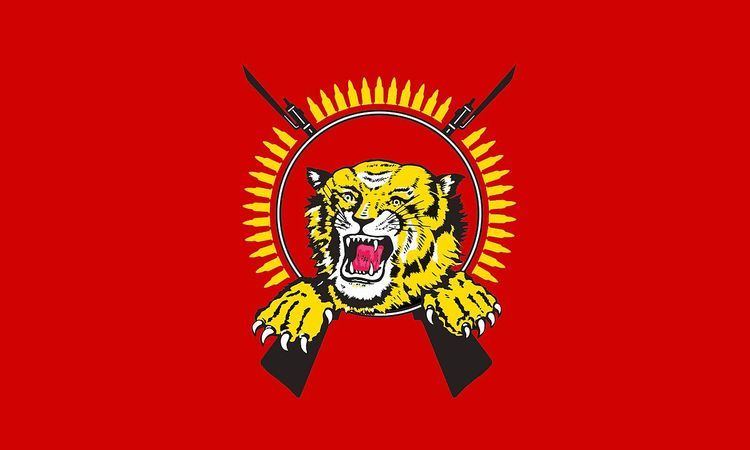Adopted November 21, 1990 | ||
 | ||
Name Puli Kodi ("Tiger flag") Design Proportion 5:9 Symbol of Liberation Tigers of Tamil Eelam Similar Flag of the Jaffna Kingdom, Flag of Pandya, Flag of Pallava | ||
The flag of Tamil Eelam was designated as the national flag of the aspirational state in 1990. The Tiger symbol of the Liberation Tigers of Tamil Eelam (LTTE) was created in 1977, differentiating it from the LTTE's emblem by leaving out the letters inscribing the movement's name. In 2005, the LTTE released a guide providing instructions and explaining the correct usage of the Tamil Eelam Flag. The guide written in Tamil specifies the regulations for flying alone or with national flags of other countries, and for general handling of the flag. The Flag has four colours, yellow, red, black, and white. It is banned in Sri Lanka and is only used by LTTE supporters around the world.
Contents
Tiger symbol
The jumping Tiger was adopted from the emblem of the Chola Empire, it should reflect the martial history (Veera varalaru) and the national upheaval of the Tamils. The national flag is the symbol of the independent state of Tamil Eelam to be created, rooted in the martial traditions (Veera marapuhal) of the Tamils," LTTE organ Viduthalai Puligal said in its February 1991 issue.
Crossed bayonets and circle
Vellupillai Prabhakaran himself mentioned in an Tamil interview the circle and crossed bayonets represent the armed resistance and were based on the historical shield with crossed swords flag of Pandara Vanniyan. The circle sometimes considered to be a "Uthaya Suriyan" (rising sun) which is a symbol of Sri Lankan Tamils and earlier political movements. The LTTE leader was often compared to Pandara Vannian of Vannimai, because both had a similar fate. Pandara Vannian was a freedom fighter during the British colonial era in Sri Lanka.
Use of the flag of Tamil Eelam in public was controversial in other countries, such as Canada, due to the depiction of the bayonets as it was believed it indirectly promoted violence. Supporters of the flag pointed out that the flag of Sri Lanka depicts a lion carrying a sword.
33 bullets
The bullets, symbolize the historical 33 years between 1948 - 1981 (oppression the Tamil population by the Sri Lankan government before the outbreak of Sri Lankan Civil War) or 1976-2009 (LTTE operated 33 years in Sri Lanka).
Colors
Four aspects of ideals and mission of Tamil Eelam represented by the four colors are detailed in the published guide book.
"Yellow signifies that Tamils' aspiration to freely govern themselves in their own homeland is a fundamental political and human right. The color expresses the righteousness of Tamil struggle and reinforces Tamil Nation's will to uphold moral highground during its path towards freedom.
Red represents the realization that freedom is not complete by establishment of a separate state of Tamil Eelam. We should abolish distinctions of caste and class. Egalitarianism should become our spiritual principle. Gender equality should permeate Tamil society. The revolutionary changes necessary to spread social justice represented by these principles are reflected by this color.
Black reminds that march towards freedom is wrought with dangers, death and destruction, that it's filled with pain and misery. Black signifies determination and resoluteness vital to withstand the adversities and build the new nation of Tamil Eelam. To provide security and to defend the borders.
White demands purity, honesty and selflessness from the leaders and citizens of Tamil Eelam.
National anthem
"Eruthu Paar Kodi" (Look the Flag is Rising) is a Tamil song penned by Puthuvai Rathinathurai, prominently featured during the hoisting of the Tamil Eelam flag. Known as the most prevalent song among Tamils, it functioned akin to a national anthem for the Liberation Tigers of Tamil Eelam, a group designated as a terrorist organization by several countries. This song was created amidst the backdrop of the Sri Lankan Civil War.
Lyrics
The song praises the flag and describes the pride of Tamil Eelam army
